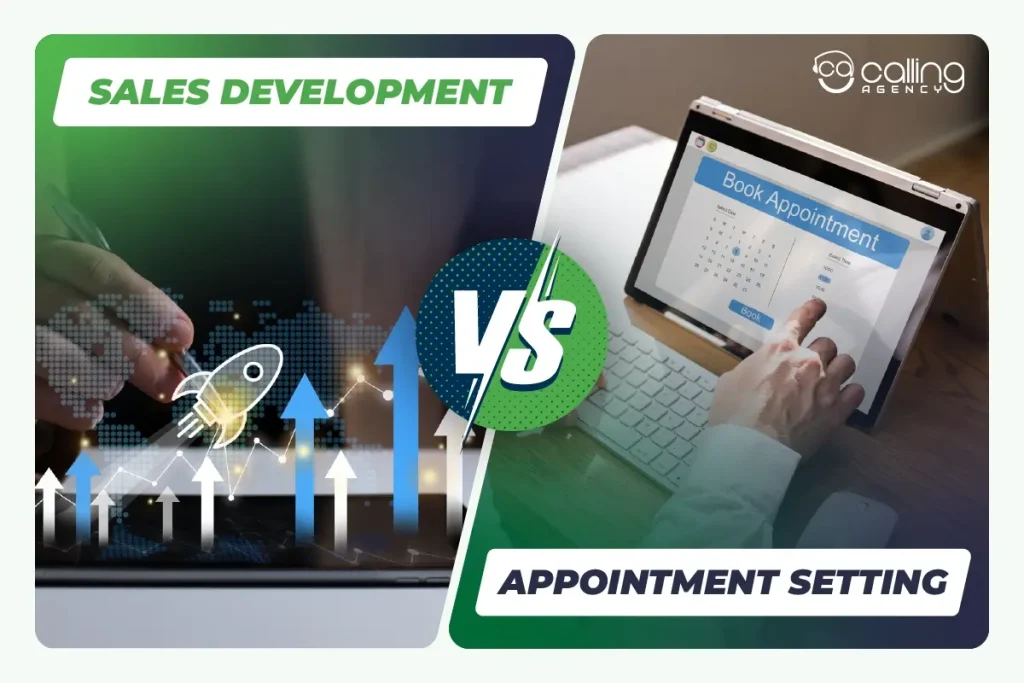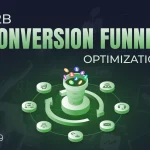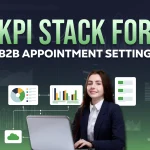Getting new customers and turning them into sales is very important for any business to grow and succeed. Different companies have different ways of doing this. Two common methods that help increase sales are called sales development and appointment setting. Both of these methods want to help move potential customers closer to making a purchase, but they do it in different ways. Each method has its own benefits based on what the business needs.
It’s important to understand the differences between these two strategies so you can choose the one that works best for your business. Let’s take a closer look at each one and see how they compare.
What is Sales Development?
Sales development is the business function that helps manage the very initial stages of the sales cycle. It focuses on identifying, connecting and qualifying potential customers. This specialized team serves as a bridge between marketing and sales and makes sure that only the well-vetted leads are passed further in the line for closing a deal.
Sales development is a part of a company that helps connect marketing and sales. Marketing generates interest from potential customers and then salespeople work to convert that interest into actual loyal customers.
Sometimes it is also called outbound sales. This process identifies people who might be inclined towards the product or service. Then, they communicate with those people to find out if they are a good match for their sales goods or services.If they seem like a good match, their details are sent to the sales team for more review. The sales team helps customers by giving them the information they need to pick the best solution for their business.
Key Responsibilities in Sales Development
The sales development team is a principal factor in generating new business. The primary role is to create and support new opportunities for sales. They work between marketing and the sales team, which helps to provide good leads that account executives can convert into sales.
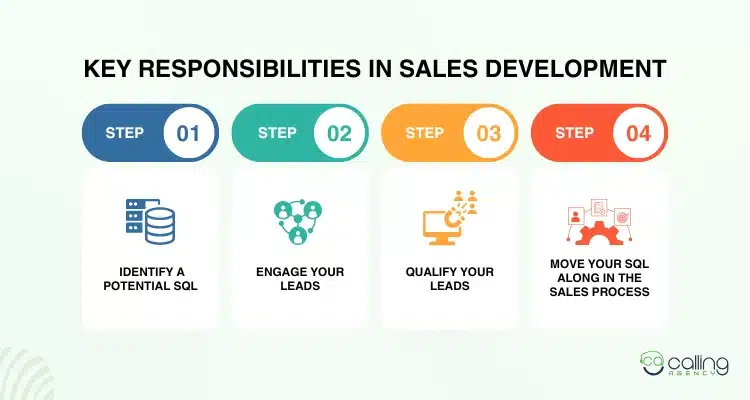
4 Steps of the Sales Development Process
Identify a Potential SQL: The first step in selling is to find out who your best customer is. When looking for potential customers, you should think about a few important things: who they are (their age, gender, etc.), what kind of business they have and how big it is, and their job details.
Engage your Leads: It is very important to establish a good relationship with future customers. When customers trust you, it is easier to make a sale. You should talk to your customers in ways that suit their age and background. For example, if you want to reach a new tech company, sending an email might be the best option. But if your customers are older, it might be better to call them or meet them face to face. Also, think about how your product or service can help them, taking into account their money situation and how quickly they need to decide.
Qualify your Leads: As a sales development representative, you want to gather as much information about your prospects as possible. This allows you to determine whether there is a likelihood of them purchasing your product or service. Use your analysis of your leads to turn their potential business into actual sales opportunities. With the information, strategize ways your company’s products or services can appeal to your prospect. This step will help your team decide if the potential customer is worth pursuing.
Move your SQL Along in the Sales Process: Once you have thoroughly vetted and primed your SQL, it is time to pass them on to the next stage of the sales process. As the first form of contact between your company and the client, take the time to introduce your prospect to your business’ account executive. Setting up a meeting is helpful for getting your client acquainted with the account executives. Prepare your executives by providing them with key information about the client. Handing over the SQL to the account executive is the last step in the sales development process, preparing both parties for a sale.
What is Appointment Setting?
B2B appointment setting means helping a company find and schedule meetings with good potential customers.
People who set these appointments talk to your best possible clients and help them feel interested. Their goal is to arrange meetings, presentations, or demos.
This process helps bring in more qualified leads (people likely to buy) for your sales team and makes selling faster. Then, all you need to do is join the call and complete the sale.
What are the Responsibilities of an Appointment Setter?
Appointment setters typically send e-mails or call the leads they obtained from a database. The following are some of an appointment setter’s other duties:
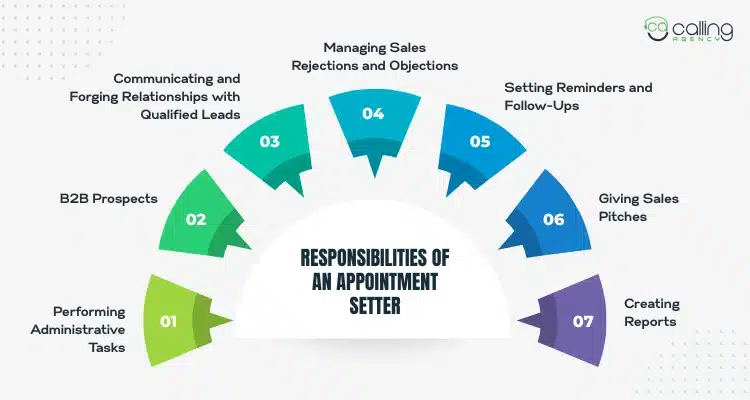
Performing Administrative Tasks
An appointment setter usually has a plan for their daily or weekly work. Their job includes making cold calls. This basically means they introduce a business’s services to new potential customers. They keep track of important numbers and take care of customer information. They also make schedules that consider the different time zones of the people they are contacting, so they can choose the best times to reach out.
Qualifying B2B Prospects
Business-to-business (B2B) means that one company talks to another company. They want to see if the other business is interested in what they sell. Before showing their products or services, appointment setters first find out if their offerings can help the other business and check how interested that business might be.
This first step is important because it helps decide if a buyer should join the sales process. This process guides the buyer through learning about the business until they are ready to buy something. Appointment setters use different ways to evaluate leads, which saves important resources like time and money.
Communicating and Forging Relationships with Qualified Leads
Appointment setters talk to people who might become clients. They ask questions to learn about the clients’ problems and needs.When they talk with people, they help the company get new customers. This is known as finding leads. They understand the important questions to ask so they can learn what the customer needs. They also know how to respond to questions about the company and what services it provides.
Managing Sales Rejections and Objections
When showing a product to potential customers, they might have questions or concerns because they need more time to see how valuable the product is. It’s the job of the person who sets the appointment-setting services to change those concerns into chances to help. They can do this by giving more information or suggesting a better time for the meeting.
Setting Reminders and Follow-Ups
After arranging a meeting between a potential client and a sales representative, appointment setters usually ensure success by sending reminders to the client. They may send an e-mail or call a few hours before the scheduled time, using the method preferred by the client.
Giving Sales Pitches
Appointment setters know how important their product or service is for potential clients. This understanding helps them create strong sales messages that show how their offerings can benefit the client’s business. They also look up information about possible clients to find useful details that can make their pitch more effective.
Creating Reports
These setters typically works closely with the sales team, preparing reports that outline their progress with leads. They maintain records of their conversations and submit a final report on their efforts to the sales manager.
Key Differences at a Glance
SDRs are people who work on finding good leads for sales, which we call sales-qualified leads (SQLs). The meetings that happen because of their work are important but not the main goal. In contrast, appointment setting is more focused. Its main goal is to schedule meetings between leads who are already interested and the sales team.
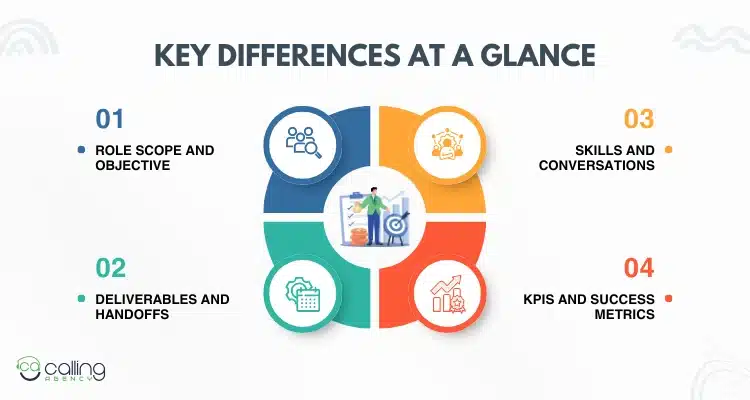
Role Scope and Objective
Sales development is a wide process that aims to find and prepare good potential customers (leads) for sales. On the other hand, appointment setting is a specific job within that process that focuses only on scheduling meetings with these interested leads. Sales development includes researching deeply, identifying problems that the leads have, and making sure they are good leads. Appointment setting is just about organizing and confirming times for the salesperson to meet these leads.
| Feature | Sales Development | Appointment Setting |
| Objective | The goal is to find and connect with potential customers. They want to make sure they are a good fit for our product, so they can build a strong list of leads that the sales team can follow up with. | To arrange a meeting or phone call between a salesperson and a possible customer. |
| Scope | A more complete process that includes thorough research, understanding what a potential customer needs and what problems they have, and helping them through different steps in the sales process. | A simple job that aims to help someone agree to set up a time to talk. |
| Role | Sales Development Representatives (SDRs) make initial contact with potential customers to determine if they are a good fit for the business. They build relationships and pass qualified leads to account executives for the next steps. | Appointment setters (or inside sales representatives) are responsible for making contact with prospects and booking those appointments. |
| Outcome | Creates a reliable stream of high-quality, sales-ready leads ready for in-depth sales discussions. | A scheduled meeting for a sales person, who then continues the discussion to learn more about the customer and help them decide to buy something. |
Deliverables and Handoffs
Sales Development is a careful process that focuses on finding good leads, known as Sales-Qualified Leads (SQLs). This means doing thorough research and checking if these leads are a good fit. On the other hand, Appointment Setting is a simpler task where the goal is just to set up meetings based on basic information, which often leads to less qualified leads.
The main difference between the two is what they deliver. Sales Development works to provide a well-researched and qualified prospect for a sales conversation. In contrast, Appointment Setting only aims to schedule a meeting.
When transferring information, Sales Development hands off a lot of important details about the qualified lead. Meanwhile, in Appointment Setting, the handoff is just to share the meeting time and some basic information with the salesperson.
Skills and Conversations
Sales development is a careful process that helps find and identify potential customers who might be ready to buy. Customers who are ready to buy are called sales-qualified leads, or SQLs. Appointment setting, on the other hand, is an easier job. It involves scheduling a meeting with someone who might like the product or service.
To do well in sales development, you need to be skilled in researching and making connections. This helps you understand what the customer truly wants. On the other hand, appointment setting is more about clear communication and being organized to set up a meeting. This usually involves using a script that has already been prepared.
KPIs and Success Metrics
Sales development is about finding good leads and building up potential sales, while appointment setting is focused on scheduling meetings so that sales representatives have a busy calendar filled with quality appointments.
To see how well the sales development team is doing, they check some important numbers called Key Performance Indicators (KPIs). These include:
- Lead Quality Score-This tells them how good the leads (potential customers) are.
- Opportunities Created– This shows how many chances they have for making sales.
- Customer Acquisition Cost (CAC)– This is how much money they spend to get a new customer.
For appointment setting, they look at different numbers to see how successful it is. These include the Number of Appointments Booked, which shows how many meetings have been scheduled, Meeting Attendance Rate, which tells how many people actually showed up for the meetings, and Meeting-to-Opportunity Conversion Rate, which measures how many meetings turned into sales opportunities.
When to Use Sales Development vs. Appointment Setting?
Use sales development to find and care for potential customers at different points in the sales process. This is more than just setting up meetings; it means building relationships and understanding their needs.
On the other hand, appointment setting is the simpler task of just scheduling a meeting with someone who is already ready to talk about making a purchase. Sales development takes more time and strategy to create a strong list of potential customers, while appointment setting focuses on quickly arranging meetings for salespeople.
Best-Fit Scenarios
Sales development is best for businesses that sell complex products. These businesses need to carefully check and build relationships with their potential customers. On the other hand, appointment setting works well for companies that have a simple sales process, lots of leads, or want to quickly start conversations with possible clients.
When deciding which approach to use, think about three important things: how complicated your sales process is, how much money you have to spend, and whether you want to have deep conversations with potential customers or just quickly set up appointments.
Best-Fit Scenarios for Sales Development
- Complex, High-Value Sales: Sales development is very important when your product or service needs a lot of explanation, several contacts, and strong relationships with customers to move forward in the sales process.
- Longer Sales Cycles: Businesses that take a long time to sell products, and have many people involved in making decisions, can gain a lot from the sales development process. This process helps find new customers and build good relationships with them.
- Deep Engagement with Leads: If your plan needs a careful way to look for potential customers, know what they need, and create a list of good prospects step by step, then sales development is the right choice for you.
- Higher Investment for In-Depth Nurturing: Sales development teams need a bigger initial investment, but they are good for companies that want to build relationships with potential customers over a long time.
Best-Fit Scenarios for Appointment Setting
- Clear Path to Sale: When it is clear how to sell something and they know the type of customer they need, making appointments to talk can be very useful.
- High Volume of Leads: If you have a lot of leads and want to set up meetings easily, you can use appointment setting. This method is a good way to do it without spending too much time checking each lead.
- Accelerated Learning and Messaging Testing: For new companies or products, setting appointments can help to quickly start real conversations with potential customers. This can provide important information to improve marketing and sales messages.
- Cost-Effective Solution: Setting up appointments can save money, especially if you hire someone else to do it. This method is useful because it focuses on getting meetings instead of having deep conversations.
Team Structures That Work
Effective sales development and appointment setting use different models to help teams work better.
- Assembly Line Model- This method divides tasks among different team members to focus on their special skills.
- Island Model– Here, each sales representative does everything from start to finish, managing the whole sales process.
- Pod Model- This is a team approach where small groups work together, focusing on specific markets or accounts.
- Hybrid Model- This mixes in-house staff with outside help to save money and grow the team, especially for reaching out to potential customers.
Choosing the best structure for your team depends on things like how complicated your product is, how long your sales process takes, and where your company is in its growth.
Workflow and Process Maps
Workflow and process maps for sales development and appointment setting show the steps a sales team takes to find potential customers and schedule meetings.
Sales Development Workflow
Here are some easy steps for a Sales Development Representative (SDR) to set up appointments:
- Find the right customers to reach out to.
- Learn about the companies you want to contact.
- Plan how you will reach out to them.
- Make phone calls to talk to leads and see if they are a good fit.
- If they are good leads, label them as Sales Qualified Leads (SQL).
- Finally, pass these good leads to an Account Executive (AE) to help close the sale.
This clear plan helps focus on the best leads and makes it easier to move into the next part of the sales process.
Appointment Setting Workflow
A good appointment-setting process consists of several key steps. First, you find potential customers who may be interested in your product or service. Next, you contact them with an interesting message. Then, you check if they are the right kind of customer for your business. Finally, you schedule a meeting by setting a time and sharing a quick summary with the salesperson.
Tech Stack and Data
Sales Development (Sales Dev) uses a mix of technology and information to find and connect with potential customers in a deeper way. On the other hand, Appointment Setting (Appt Setting) uses specific tools to focus on the main goal of booking meetings.
For Sales Dev, the tools include Customer Relationship Management (CRM) systems, platforms to help engage with sales, and lead intelligence to discover and qualify potential clients. In contrast, Appt Setting relies on outreach tools, calendar software, and basic CRM information to help schedule meetings with qualified prospects more efficiently.
Core Tools
Sales Development Representatives (SDRs) work on finding and building relationships with potential customers to turn them into Sales Qualified Leads (SQLs). This means they do a lot of research to understand the needs of these leads. On the other hand, appointment setting is a simpler job where the focus is just on scheduling meetings with people who might be interested in a product or service for a sales talk.
SDR
- CRM (Customer Relationship Management): A system that gathers and organizes information about customers and potential customers, keeps track of their interactions, and helps manage the sales process.
- SEP (Self-Employed Person): This term is not commonly used in sales technology. It might be a mistake or a misunderstanding. In sales, it could be referring to a specific tool, a target market, or a process, but it doesn’t have a clear meaning in this area.
- Data Providers: Companies that provide lists of business contacts with checked email addresses, phone numbers, and company information. These lists help sales development representatives (SDRs) find and create lists of potential customers.
- Intent Data: Signals that show when a possible customer is looking for a product or service like yours. This helps Sales Development Representatives (SDRs) focus on the leads that are most likely to make a purchase.
- Data Enrichment: The process of automatically completing missing or outdated information in contact records. This helps provide more details, such as job titles, technology used, and customer behavior, to make sales efforts better.
- LI Outreach (LinkedIn Outreach): Use LinkedIn Sales Navigator and other tools to find potential customers on LinkedIn. Take advantage of their work information to start personal conversations and build stronger relationships.
- Call Dialer: A tool that helps make sales calls automatically. It often uses smart technology to time the calls better, recognize when someone answers or if it’s an answering machine, and increase the chances of connecting with people for Sales Development Representatives (SDRs).
Appointment Setting
It uses tools that are often used in sales and customer service software. Appointment setting helps manage schedules, routing directs calls to the right person, a dialer automatically makes calls, voicemail drops allow you to send recorded messages quickly, and reminders help notify people about their appointments.
These tools make it easier to reach out and follow up with customers by automating communication processes. This enhances your ability to connect quickly and efficiently with potential clients and customers.
Data and Governance
Sales development and appointment setting are different in how they use data and follow rules. Sales development is a detailed and strategic process aimed at creating high-quality leads, known as Sales Qualified Leads (SQLs). It needs deep, qualitative information to carefully nurture and qualify these leads, along with strong rules to keep the data reliable for making smart decisions.
On the other hand, appointment setting is much simpler and focuses on scheduling meetings with leads that have already been pre-qualified. It uses more basic, quantitative data for direct outreach and organizing meetings. The rules in this process focus on being efficient and making sure that appointments are set consistently.
An Ideal Customer Profile (ICP) helps you identify your best customers. Buying committee mapping shows you who in those companies makes the buying decisions. To use an ICP effectively, you need to have good data and follow rules, like respecting Do-Not-Call (DNC) lists and managing consent. This is important for Sales Development (SDR) and setting up appointments. It helps you target the right companies, understand what they need, and create strong relationships through personalized and respectful communication.
In simple terms, the process of tracking leads goes like this:
- MQL (Marketing Qualified Lead)– This is when someone shows interest in a product or service but isn’t fully ready to buy.
- SAL (Sales Accepted Lead)-This is when the sales team checks and agrees that the lead meets certain basic requirements.
- SQL (Sales Qualified Lead)- This shows that the lead is very interested and is a good fit for the sales team to talk to more seriously.
For data management, the Sales Development (SD) team focuses on changing MQLs to SALs. They use codes like “Product Interest” or “Company Fit” to help understand if the lead is good.
On the other hand, the Appointment Setting (AS) team works on turning SALs into SQLs. They use codes such as “Meeting Booked,” “No Show,” or “Not Interested” to track the engagement level of leads and ensure good data governance.
Cost, Compensation, and Outsourcing
Sales development jobs usually cost more than appointment-setting jobs. The average salary for a Sales Development Representative (SDR) is about $57,763, plus extra money, while appointment setters make around $39,000. Hiring outside companies for appointment setting can save money because it eliminates the costs of hiring and training people in-house. Outsourcing can also help with tasks like finding leads and setting appointments, which reduces additional costs.
Compensation Models
Compensation Models for Sales Development Representatives (SDRs)
- Base Salary + Commission: This is a common model that provides a stable base income while also offering performance-based bonuses, often tied to revenue generated from qualified leads or closed deals they hand off.
- Quota-Based Bonuses: SDRs may receive bonuses for exceeding targets for qualified leads or opportunities created, directly incentivizing their efforts in moving prospects through the sales funnel.
- Presales Incentives: For longer sales cycles, SDRs might be rewarded for reaching specific milestones before a deal closes, such as a qualified meeting or product demo.
Compensation Models for Appointment Setters
- Activity-Based Incentives: These plans reward the volume and quality of appointments booked. A set amount is paid for each qualified appointment, or even for each call made or email sent.
- Commission-Based (Per Appointment): In some models, appointment setters can earn a commission for every high-quality meeting they set that results in a positive outcome for the sales team.
- Base Salary + Activity Incentives: Similar to SDRs, appointment setters might receive a steady base salary to provide income stability, supplemented by bonuses for achieving activity metrics, such as the number of appointments set.
ROI Considerations
Sales Development usually gives a better and more consistent Return on Investment (ROI) because it can manage more complicated sales situations and go further in the sales process. On the other hand, Appointment Setting works best for simple sales where getting high-quality leads quickly to set up meetings is the main goal.
For Sales Development, the key to getting good ROI is using resources wisely to create a stronger and more reliable sales funnel. In contrast, for Appointment Setting, the ROI depends on how good the leads are and how cost-effective the service is.
Conclusion
Both appointment setting and sales development are important, but sales development is often better at turning good leads into real customers. It focuses on creating meaningful connections and building strong relationships by being more careful and personalized in how it approaches potential clients.
Sales development works to nurture leads, meaning it helps them understand how a product or service can meet their needs. This way, every conversation becomes important, increasing the chances of making a sale and helping people remember the brand positively. While appointment setting is great for getting initial meetings, sales development is what really helps turn those meetings into valuable, long-lasting partnerships.
FAQ
Is Sales Development the Same as Appointment Setting?
Sales Development is different from appointment setting. Sales Development is a complete process that includes finding new customers, building relationships with them, and making sure they are ready to buy. This leads to what are called Sales-Qualified Leads (SQLs). On the other hand, appointment setting is a smaller job that focuses only on arranging meetings. It is just one part of the larger Sales Development process.
Which is Better for Enterprise Sales?
There isn’t just one “best” tool for selling in big companies; it’s a combination of various tools that streamline the process. Key tools include:
– CRM software (e.g., Salesforce, HubSpot) for managing customer information.
– Sales engagement tools (e.g., Outreach, Salesloft) to connect with customers.
– Data intelligence platforms (e.g., Cognism, LinkedIn Sales Navigator) for insights on potential customers.
– Revenue intelligence tools (e.g., Gong, Clari) to analyze sales performance.
Using these tools together enhances efficiency in the complex selling process.
How Do I Improve Show Rates?
To improve show-up rates, use automation for reminders and rescheduling, offer flexibility in scheduling, personalize your communication, and build anticipation with pre-meeting content and consistent engagement.
What Should Count as an SQL?
A fundamental SQL command used to count the number of rows that meet specific criteria or all rows in a table, often used for reporting, analytics, and data integrity checks.
When Should I Outsource Appointment Setting?
This means you only pay for the results you get, not for extra costs like hiring and training new staff. It’s also flexible: if you need more appointments during busy times or want to do less when it’s slow, outsourced services can easily adjust to your needs.
Do SDRs or Appointment Setters Handle Discovery?
SDRs (Sales Development Representatives) do a basic check to see if potential customers are a good fit, while appointment setters mainly aim to book a meeting. Appointment setters often don’t do as much checking to qualify the leads.


